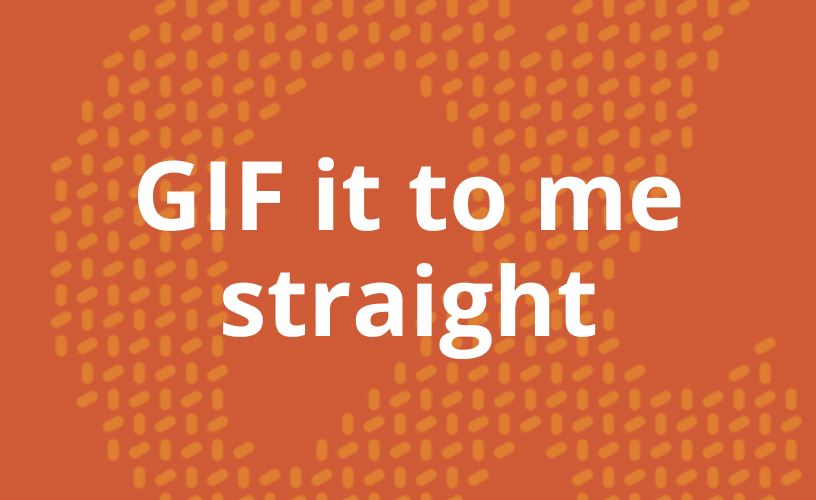
GIF IT TO ME STRAIGHT
OR,
HOW TO IMPROVE YOUR B2B MARKETING IN A GIF

According to segments of the internet,
no debate has raged so wildly
as the one over how to pronounce “GIF.”
You say it like the peanut butter brand. Fine. I say it like the thing that gets wrapped in nice paper and bows.
[Nervous silence in the room.]
See? Coexisting isn’t so bad, eh?
We can set all that aside because what we’re really interested in today is using GIFs effectively in marketing. Turns out they’re wicked effective — and we have the results to show it.
What is a GIF, anyway?
Like NASA or PTO, people often use “GIF” without knowing what it really means. GIF stands for Graphical Interchange Format, and if you really want to know, it’s a file type that can support up to 8 bits per pixel and can contain 256 indexed colors.
GIFs are also laborious to create and manage, and on first glance they bring some real disadvantages:
- Design and troubleshooting are more complicated than MP4s, and revisions can take longer due to export issues.
- Resolution/quality expectations should be tempered due to the nature of the file type, compression, and other factors.
- GIFs also must be kept simple because the more colors and design elements there are, the more chances for complications or low-fidelity images.
You’ll also need to establish the most updated platform/channel specs before starting a GIF project, since those are always moving targets.
Why use GIFs at all?
Because they’re damn fun — so much so that audiences behave differently in their presence.
When used properly, GIFs can:
- Add more visual intrigue with their looping motion
- Support increased click engagement across different channels
- Add that pop and jazz

GIFs are best used when an MP4 can’t or shouldn’t be used but there’s still a need for visual interest and increased engagement actions, like a click. Typical deployments include:
- Social
- Display ads
GIFs are especially useful with niche display ad publishers that don’t accept HTML5 formats — though HTML5 is generally superior and should be used when possible.
Case studies
Many of our B2B enterprise clients ask us to strategize and deploy their digital marketing, which includes social and email. This is handy, since it gives us great first-hand data about what works (instead of reading some blog post…who does that?).
Hint: GIFs work.
Case study #1: GIFs in email campaigns
We recently A/B tested GIFs in an extended email campaign for a top engaged audience. The results were striking.
- Averaged 2021 CTOR (pre-GIFs): 13.9%
- Averaged 2022 CTOR (GIFs introduced in March/April): 17.9%

Case study #2: GIFs on social
In 2022, we also tested static image, video, and animated GIF posts throughout the client’s year-long social media strategy. We found that:



Conclusion: Keep them in your toolbelt.
In general, HTML5/MP4 file types are preferable because of their ease of use, flexibility, and high quality. GIFs are best used sparingly for use cases that can’t be satisfied by another file type.
However, if you have a great GIF idea and a venue to use it, it’s probably worth investing in. As we’ve seen, GIFs produce great engagement as part of a paid media strategy and in marketing emails. They might even make your job more fun.
However you pronounce them.

